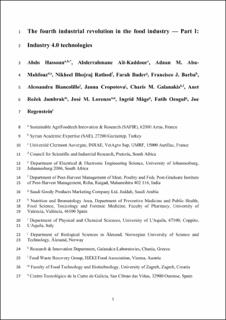The fourth industrial revolution in the food industry—Part I: Industry 4.0 technologies
| dc.contributor.author | Hassoun, Abdo | |
| dc.contributor.author | Aït-Kaddour, Abderrahmane | |
| dc.contributor.author | Abu-Mahfouz, Adnan M. | |
| dc.contributor.author | Rathod, Nikheel Bhojraj | |
| dc.contributor.author | Bader, Farah | |
| dc.contributor.author | Barba, Francisco J. | |
| dc.contributor.author | Biancolillo, Alessandra | |
| dc.contributor.author | Cropotova, Janna | |
| dc.contributor.author | Galanakis, Charis M. | |
| dc.contributor.author | Jambrak, Anet Režek | |
| dc.contributor.author | Lorenzo, José M. | |
| dc.contributor.author | Måge, Ingrid | |
| dc.contributor.author | Özogul, Fatih | |
| dc.contributor.author | Regenstein, Joe M. | |
| dc.date.accessioned | 2022-08-12T08:21:59Z | |
| dc.date.available | 2022-08-12T08:21:59Z | |
| dc.date.created | 2022-02-19T08:29:13Z | |
| dc.date.issued | 2022 | |
| dc.identifier.issn | 1040-8398 | |
| dc.identifier.uri | https://hdl.handle.net/11250/3011536 | |
| dc.description.abstract | Climate change, the growth in world population, high levels of food waste and food loss, and the risk of new disease or pandemic outbreaks are examples of the many challenges that threaten future food sustainability and the security of the planet and urgently need to be addressed. The fourth industrial revolution, or Industry 4.0, has been gaining momentum since 2015, being a significant driver for sustainable development and a successful catalyst to tackle critical global challenges. This review paper summarizes the most relevant food Industry 4.0 technologies including, among others, digital technologies (e.g., artificial intelligence, big data analytics, Internet of Things, and blockchain) and other technological advances (e.g., smart sensors, robotics, digital twins, and cyber-physical systems). Moreover, insights into the new food trends (such as 3D printed foods) that have emerged as a result of the Industry 4.0 technological revolution will also be discussed in Part II of this work. The Industry 4.0 technologies have significantly modified the food industry and led to substantial consequences for the environment, economics, and human health. Despite the importance of each of the technologies mentioned above, ground-breaking sustainable solutions could only emerge by combining many technologies simultaneously. The Food Industry 4.0 era has been characterized by new challenges, opportunities, and trends that have reshaped current strategies and prospects for food production and consumption patterns, paving the way for the move toward Industry 5.0. | en_US |
| dc.language.iso | eng | en_US |
| dc.publisher | Taylor and Francis Group | en_US |
| dc.title | The fourth industrial revolution in the food industry—Part I: Industry 4.0 technologies | en_US |
| dc.type | Journal article | en_US |
| dc.type | Peer reviewed | en_US |
| dc.description.version | acceptedVersion | en_US |
| dc.rights.holder | Publisher embargo applies until Febuary 3; 2023. This is an Accepted Manuscript of an article published by Taylor & Francis in Critical reviews in food science and nutrition on 03 Feb 2022 , available at: https://doi.org/10.1080/10408398.2022.2034735 | en_US |
| dc.source.journal | Critical reviews in food science and nutrition | en_US |
| dc.identifier.doi | 10.1080/10408398.2022.2034735 | |
| dc.identifier.cristin | 2003571 | |
| cristin.ispublished | true | |
| cristin.fulltext | original | |
| cristin.qualitycode | 1 |
